Physical Address
304 North Cardinal St.
Dorchester Center, MA 02124
Children are not small adults. Although many similar treatment principles and techniques are utilized, a number of special considerations are required in the treatment of hand fractures in skeletally immature patients. Examination of the injured hand can be challenging, particularly in an anxious or nonverbal child. Accurate diagnosis is dependent on clinical history, careful observation, and skilled physical examination. These challenges are compounded by the smaller size of the affected musculoskeletal structures and the abundant surrounding subcutaneous fat and soft tissue. In addition, the smaller size of the underlying skeletal structures necessitates the use of smaller implants placed with precision during surgical procedures. Although the robust healing potential of skeletal injuries in children reduces the risk of delayed union and nonunion compared with their adult counterparts, it also narrows the window of opportunity to correct deformities using closed means. Much of this robust healing potential arises from the thick and biologically active periosteum, which contributes to appositional bone growth, promotes remodeling, and provides a smooth gliding surface for overlying tendons.
The presence of the physis leads to a unique set of treatment considerations. In many situations, an initial bony deformity will remodel with continued skeletal growth. This remodeling potential is dependent on a number of factors, including the magnitude and pattern of bony deformity, proximity of the injury to the adjacent physis, and amount of remaining skeletal growth. In general, the greatest remodeling potential is seen with displacement in the plane of adjacent joint motion, in close proximity to the physis, and in young children with many years of remaining growth. , Rotational deformity has little remodeling potential and will persist if not addressed acutely. Similarly, remodeling of radioulnar (coronal) angulation is limited and is dependent on the amount of adjacent radioulnar joint motion. Efforts to preserve physeal growth may also influence the choice of surgical techniques for operative injuries.
Because children demonstrate varying degrees of compliance following injury or postoperative care, more restrictive immobilization is required to maximize long-term outcomes. Fortunately, the use of longer and more restrictive immobilization following hand fractures in children is not associated with the stiffness seen in adults. Indeed, children are often their own best therapists and quickly resolve issues of stiffness and strength through daily activities of play and sports.
In addition to these considerations, a number of hand injuries are characteristically found in children. Awareness of these injuries and their treatment options is essential for the practicing hand surgeon.
The purpose of this section is to review the epidemiology, pertinent anatomy, and treatment principles for fractures of the child’s hand, with particular emphasis on pediatric injuries requiring surgical care.
Hand fractures are common in children and adolescents. In their analysis of the 1998 National Hospital Ambulatory Medical Care Survey (NHAMCS), Chung and Spilson reported on the epidemiology of hand and forearm fractures in the United States. Based on their four-stage probability model and subsequent extrapolation of the NHAMCS data, an estimated 1,465,874 hand or forearm fractures present to U.S. emergency departments annually. Phalangeal and metacarpal fractures represented 23% and 18% of these cases, respectively. Interestingly, 15% of all metacarpal fractures and 33% of all phalangeal fractures occurred in patients between 0 and 14 years of age. Furthermore, the highest rate of multiple hand fractures was seen in patients between 0 and 4 years of age (29.8%). The calculated incidence of phalangeal fractures in patients 0 to 4 years old was 207.2 per 100,000. The incidence of metacarpal and phalangeal fractures in patients 5 to 14 years old was 100.0 and 184.9 per 100,000, respectively. Although this analysis was limited by the study design and the nature of the NHAMCS database, the results clearly highlight the frequency with which hand fractures occur in the pediatric population.
Feehan and Sheps performed a population-based study evaluating the epidemiology of hand fractures in British Columbia, Canada, from 1996 to 2001. During the 5-year study period, 72,481 fractures were identified, for an overall annual incidence of 3.63 per 1000 across all age groups. The peak incidence for hand fractures was between 10 and 14 years of age (8.69 per 1000). When divided according to gender, the highest incidence was seen in males between 15 and 19 years of age (12.3 per 1000) and females between 10 and 14 years of age (5.3 per 1000). The authors attributed this peak incidence during adolescence to a combination of accelerated skeletal growth and participation in higher-risk sporting and recreational activities.
Over a 6-month period in 2000 at the Pulvertaft Hand Center in Derby, England, 360 children younger than 16 years were seen for hand injuries. Skeletal injuries accounted for 66% of cases, for an annual incidence of 418 per 100,000 children. The peak incidence was in patients between 10 and 16 years of age. Although crushing injuries were the most common mechanism overall, sports-related fractures occurred most commonly in patients older than 10 years. The small finger was most commonly fractured (52%), followed by the thumb (23%). The proximal phalanx was the most frequently injured phalanx (67%). Metacarpal fractures were most commonly diaphyseal, whereas phalangeal fractures typically involved the proximal metaphysis or physis.
Shah et al. more recently reported their retrospective analysis of the National Electronic Injury Surveillance System of patients less than 18 years of age treated at U.S. emergency departments from 1990 to 2009. They estimated an incidence of hand injuries at 11.6 per 1000. Approximately one-quarter of all hand injuries consisted of fractures, most commonly affecting patients between 10 and 14 years of age from recreational and sporting activities. In 2019 Lee and colleagues reported 11.7 million emergency department encounters from 2008 to 2012 for pediatric hand and upper extremity injuries using the National Emergency Department Sample. During these 4 years, there were $21.2 billion of charges related to these injuries.
In addition to the wealth of information on the frequency of hand fractures in children and adolescents, a number of published reports have provided insights into the mechanisms and patterns of injury. Combining these reports and previous epidemiologic studies, there is a biphasic distribution of hand injuries, with peak incidences in young toddlers and older adolescents. Bhende and coworkers analyzed 464 children with 477 hand injuries presenting to a level I pediatric emergency department during a 6-month period in 1989. Fractures accounted for 19.3% of all hand injuries, and a bimodal distribution of injuries was seen. Toddlers and younger children presented with lacerations, burns, and fingertip injuries—such as distal phalangeal fractures—as they explored the world around them. Conversely, adolescents tended to present with hand fractures sustained during sporting activities, fights, and self-inflicted trauma. Liu et al. and Young et al. support these findings in their separate analyses of children presenting to plastic surgery emergency clinics. , There also appears to be a seasonality to the incidence of these injuries, with peaks in the spring and fall and lower volumes during the winter.
Rajesh and associates similarly attempted to characterize the pattern and nature of pediatric hand fractures in their radiographic review of 280 children treated at the Leicester Royal Infirmary in the United Kingdom. Isolated distal phalangeal tuft fractures were most common in the 0- to 4-year age group. Distal phalangeal tuft and shaft fractures were most common in 5- to 8-year-old children. Small finger proximal phalangeal fractures were most common in patients 9 to 12 years of age, and small finger metacarpal neck fractures were seen most often in 13- to 16-year-old adolescents ( Fig. 41.1 ). Other published reports have also documented a higher frequency of injury to the border digits, especially the small finger. ,
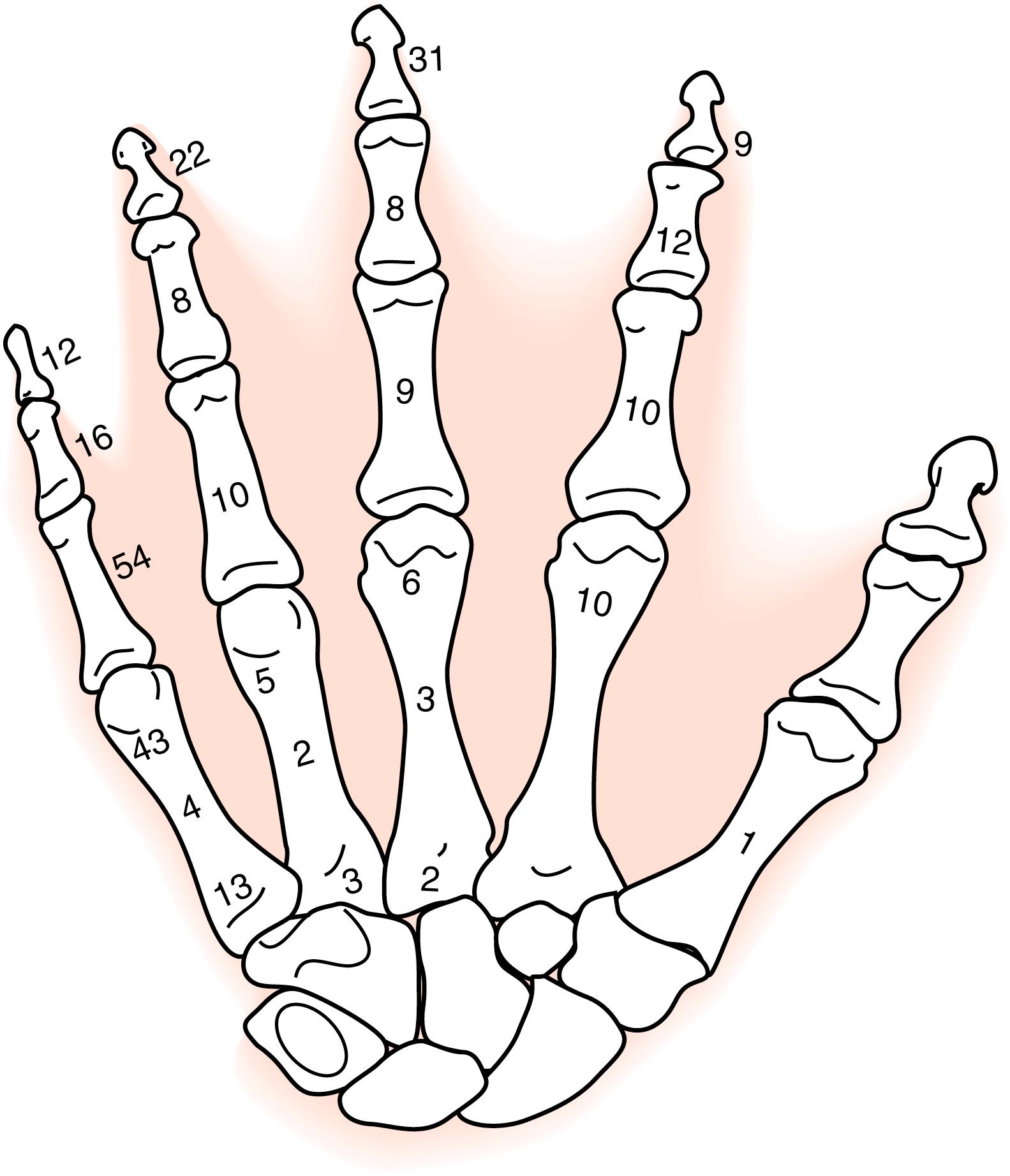
Approximately one-third of all fractures of the hand propagate through the phalangeal or metacarpal physis. , Salter-Harris type II fracture patterns predominate, most commonly of the proximal phalanx. , , Despite the relative frequency of physeal fractures, posttraumatic physeal arrest is an uncommon sequela in isolated closed injuries.
Physical examination of a child’s injured hand can be challenging, particularly in an anxious, noncompliant, or nonverbal patient. Observation and gentle maneuvers are mandatory to obtain the information needed for an accurate and timely diagnosis. The presence of swelling, ecchymosis, guarded active motion, or soft tissue injury can guide the examiner to the region of pathology.
The tenodesis effect or gentle pressure applied to the more proximal muscle bellies of the forearm (away from the site of injury) aids in the assessment of both tendon integrity and angular or rotational deformity. Assessment of rotational deformity is critical because rotational remodeling is limited and may result in compromised hand function due to digital overlap or underlap. Malrotation can also be assessed by careful examination of the nail beds of adjacent digits in extension; rotation of greater than 10 degrees out of the plane of adjacent nail plates should alert the examiner to rotational malalignment, although these differences can be subtle and difficult to quantify. Rotational deformity can be better assessed by evaluating digital alignment with attempted finger flexion ( Fig. 41.2 ). In general, the index through small fingers point to the scaphoid tubercle in flexion, roughly in parallel alignment. Often, patients normally exhibit some degree of digital underlap, such as the small beneath the ring finger. Comparison to the uninjured contralateral hand is valuable in these situations to determine baseline alignment. In young, anxious, or nonverbal patients who are unable to actively flex their digits during physical examination, the tenodesis effect can be used. Gentle passive extension of the wrist yields obligate digital flexion to assess for rotational alignment. Only after all pertinent information has been derived from observation and indirect examination techniques should direct palpation or stress testing be performed.
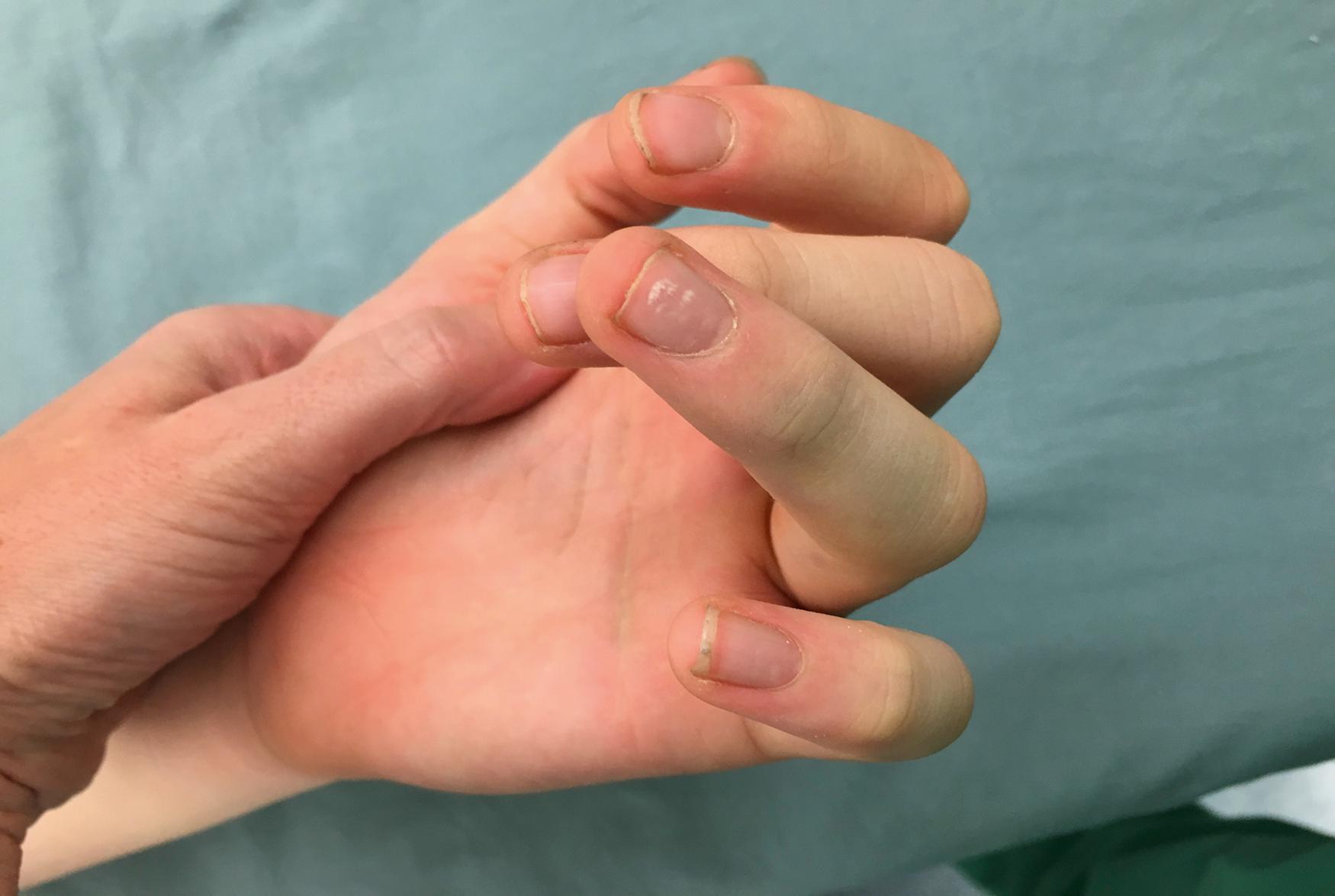
Sensibility is difficult to elicit in young patients, and threshold testing or two-point discrimination is generally unreliable until children are older than 8 years. In rare situations where there is concern about an associated digital nerve injury, warm water immersion can be used. The presence of skin wrinkling or pruning after several minutes of water immersion implies innervation and intact digital nerves ( Fig. 41.3 ).
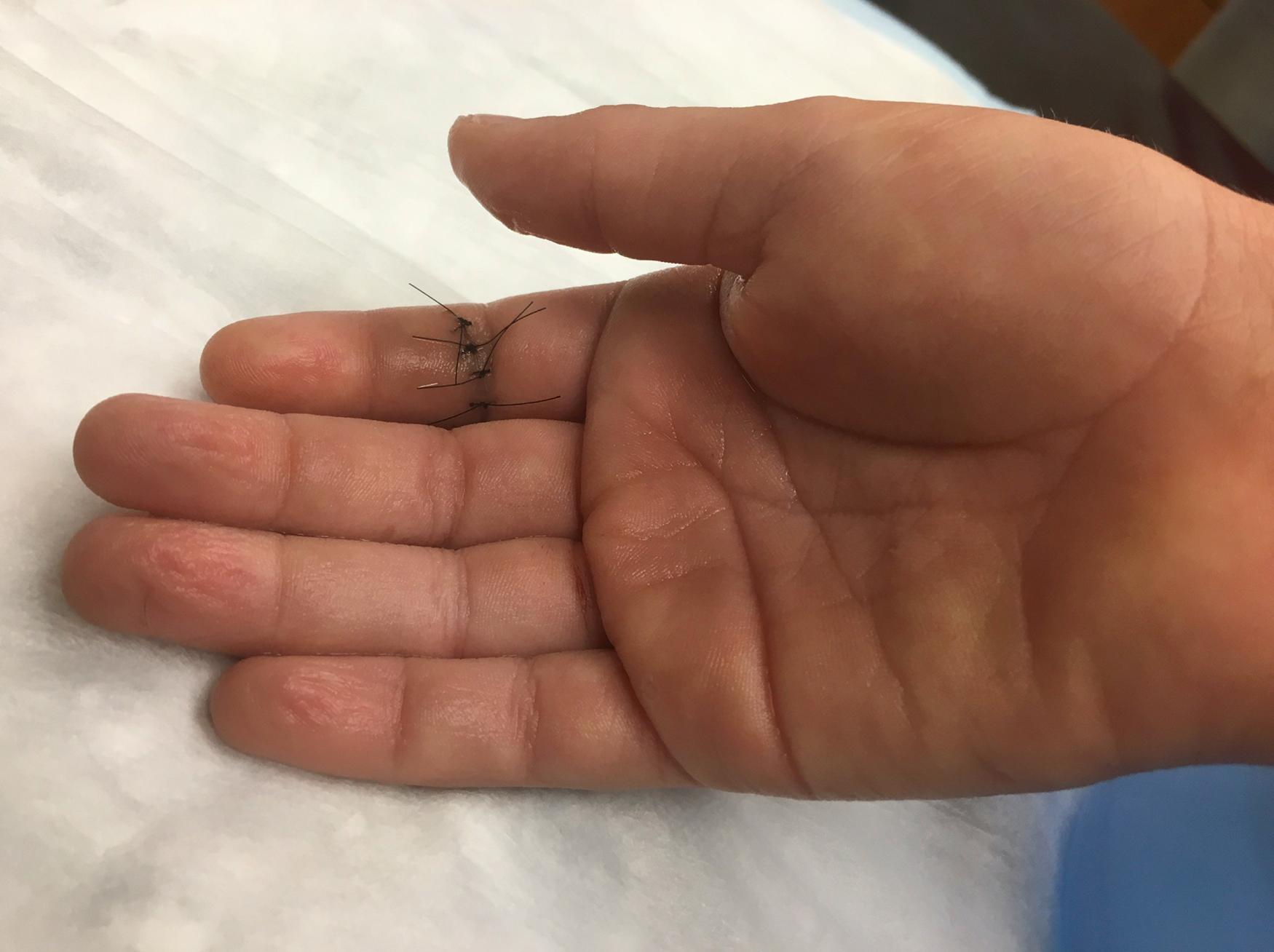
Thorough and directed radiographic evaluation is imperative in the evaluation of a child’s injured hand. In general, dedicated anteroposterior (AP), lateral, and oblique radiographs of the injured digit are preferred over hand radiographs, which project artifacts (e.g., shadowing or distortion) and degraded image quality that can lead to errors in diagnosis. As part of the systematic evaluation of hand radiographs, the phalangeal line test has been proposed as a means of identifying joint malalignment or bony angulation in younger children whose skeletal structures are not yet ossified ( Fig. 41.4 ). When expedited or comprehensive radiographic assessment is needed, fluoroscopy or mini-imaging units may assist in obtaining appropriate views of the injured digit, comparison views of the contralateral hand, or dynamic assessment of bony and articular stability. As ultrasonography becomes increasingly ubiquitous, ultrasound imaging may similarly be used to detect subtle or radiographically occult fractures. The normal sequence of skeletal ossification, as well as common normal radiographic variants (discussed later), must be recognized to avoid mistaking these for traumatic injuries. , Indeed, Chew and Chong previously reported on 204 children referred to a tertiary care center for hand fractures; injuries were misdiagnosed in 16 cases (8%) with mistaking the epiphyses for fractures the leading cause.
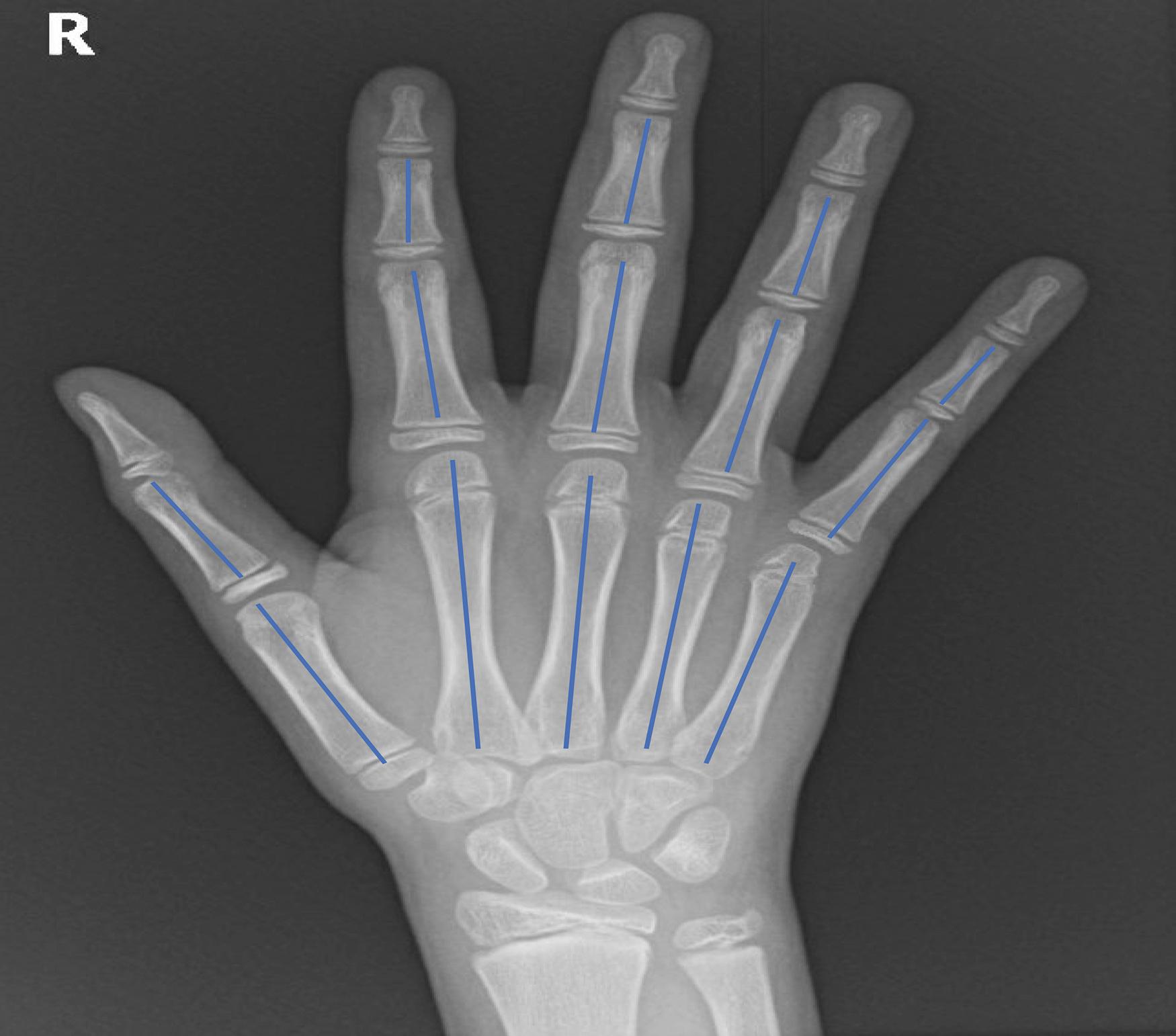
Among the many proposed classification systems, the Salter-Harris is most widely used. The schema is straightforward, guides fracture management, and prognosticates outcome ( Fig. 41.5 ).
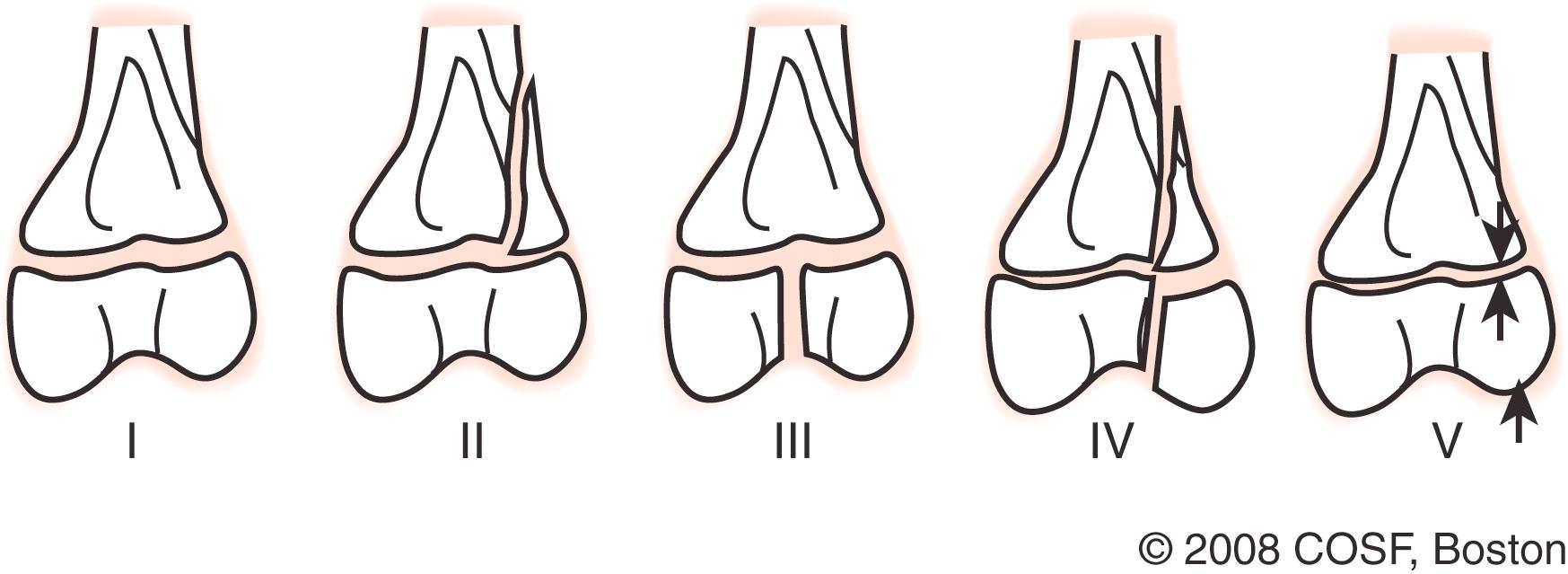
In the skeletally immature hand, the physes of the phalanges lie perpendicular to the long axis of the bones and are located proximal. The metacarpal physes are distal, with the exception of the thumb metacarpal, which is proximal.
The secondary centers of ossification in the epiphyses appear in a timely and orderly fashion. Although there is variation among individuals, the proximal phalangeal epiphyses become radiographically apparent between 10 and 24 months of age, in females before males. , The epiphyses of the middle and distal phalanges ossify approximately 6 to 8 months later. Conversely, physeal closure proceeds in a distal to proximal direction, typically between the ages of 14 and 16 years. The index through small metacarpal epiphyses ossify at 12 to 27 months of age and fuse between 14 and 16 years of age. The thumb metacarpal epiphysis, however, does not typically ossify until 24 to 36 months of age.
Common normal radiographic variants include the appearance of a pseudoepiphysis of the distal thumb metacarpal and the proximal index metacarpal. The pseudoepiphyses become radiographically apparent at an early age, do not contribute to the longitudinal growth of the metacarpal, and typically fuse to the metacarpal diaphysis by the seventh year of life. Other anatomic variants include the double epiphysis, most commonly appearing in the index and thumb metacarpals. These physeal variants can be misinterpreted as fractures.
As in other long tubular bones that develop via enchondral ossification, the physis of the phalanges and metacarpals is divided into a number of histologic zones. Proceeding from the epiphysis to the metaphysis, the physis contains a resting zone, proliferative zone, zone of hypertrophy, and zone of provisional calcification. Because most physeal fractures propagate through the zone of hypertrophy without disrupting the resting or proliferative zone, posttraumatic growth disturbance is an uncommon sequela of pediatric hand fractures. In the less common circumstance in which the plane of cleavage traverses the zone of proliferation or the resting zone (e.g., Salter-Harris type III, IV, and V fractures), physeal arrest may occur. As the physis becomes more irregular and calcified as patients approach skeletal maturity, Salter-Harris type III and IV injuries are more likely to occur, mimicking more adult fracture patterns (e.g., Bennett fracture at the base of the thumb metacarpal).
Knowledge of the soft tissue anatomy is critical in understanding common fracture patterns and guiding nonoperative as well as surgical treatment. In the interphalangeal (IP) joints, the collateral ligaments arise from the collateral recesses of the phalangeal neck proximally and insert to the epiphysis and metaphysis of the adjacent phalangeal base distally. Conversely, at the metacarpophalangeal (MCP) joint, the radial collateral ligament arises from the metacarpal epiphysis proximally and inserts on the proximal phalangeal epiphysis distally; the ulnar collateral ligament originates from both the metacarpal epiphysis and metaphysis and inserts on the proximal phalangeal epiphysis. For these reasons, Salter-Harris III fractures are common about the MCP joint but rarely involve IP joints because the epiphysis is “protected” by the collateral ligaments. Conversely, diaphyseal or Salter-Harris II fractures of the distal phalanx or fractures of the proximal phalangeal head or neck more commonly arise from laterally directed forces on the IP joints.
Understanding of the tendinous insertions in the hand also helps elucidate fracture patterns and guide treatment. The terminal tendon of the long digital extensor inserts onto the dorsal phalangeal epiphysis. The flexor digitorum profundus insertion to the index through small fingers spans both the volar epiphysis and metaphysis. This anatomic relationship is particularly relevant in the treatment of distal phalangeal physeal fractures, as described later. In the thumb, the extensor pollicis longus inserts onto the dorsal epiphysis of the distal phalanx, the extensor pollicis brevis inserts onto the epiphysis of the proximal phalanx, and the abductor pollicis longus inserts broadly on both the epiphysis and metaphysis of the thumb metacarpal. The flexor pollicis longus inserts on the metadiaphysis of the distal phalanx.
Most hand fractures in children can be managed nonoperatively on an outpatient basis. , , , Only 10% to 20% of pediatric hand fractures require surgical care.
Hastings and Simmons published a retrospective analysis of 354 hand fractures in skeletally immature patients. Border digits were most commonly fractured, and the metacarpal and proximal phalanx were most commonly affected. There were only two cases of growth disturbance following severe crush injuries or infection. Overall results were excellent in most cases, but a number of risk factors were associated with fracture malunion and poor results, including failure to obtain adequate radiographs at the time of injury, false assumptions regarding the remodeling potential of phalangeal fractures, and failure to evaluate clinical deformity (i.e., malrotation). Displaced articular fractures, physeal fractures of the distal phalanx, phalangeal neck fractures, and open fractures were identified as high-risk fractures for suboptimal outcomes ( Box 41.1 ). Given this information, identification and treatment of these fractures are emphasized in the following sections.
Articular fractures, including Salter-Harris type III fractures of the proximal phalanges
Distal phalangeal physeal fractures (Seymour fractures)
Phalangeal neck fractures
Open fractures
Most distal phalangeal fractures are successfully treated without surgery. Identifying open fractures and subsequent operative treatment uniformly leads to a satisfactory outcome.
Fractures of the distal phalanx typically result from crush injuries in younger patients. In general, these fractures are extraphyseal injuries with varying fracture patterns, including transverse, longitudinal split, and comminuted configurations. These bony injuries are often accompanied by soft tissue avulsions and/or nail bed lacerations. Treatment is predicated on stabilization of the skeletal injury and appropriate soft tissue injury care, including wound irrigation and debridement, nail plate removal, and nail bed repair as indicated. , Although the majority of distal phalangeal fractures can be treated effectively with splint or cast immobilization, surgical stabilization is occasionally needed for widely displaced injuries. In these situations, a single Kirschner wire placed through the digital tip and across the fracture site will suffice. Some authors have proposed using a hypodermic needle placed under local anesthesia for fracture stabilization.
The majority of extraphyseal distal phalangeal fractures are treated with simple splint or cast immobilization for 4 weeks, with excellent healing and outcomes. Rarely, if complete displacement or translation occurs in transverse fracture patterns, Kirschner wire fixation is used to maintain reduction. A single Kirschner wire is passed in a retrograde fashion through the fingertip, across the fracture, and across the distal interphalangeal (DIP) joint, engaging the head of the middle phalanx. The wire is bent and cut outside the skin. The wire is removed in the office after 4 weeks, followed by range-of-motion exercises and return to activities as symptoms abate.
Salter-Harris I fractures result in the so-called pseudomallet fracture as the distal diaphyseal fragment is displaced in a volar direction, with apex dorsal angulation, by the pull of the flexor digitorum profundus. Treatment requires extension splinting of the distal phalanx and DIP joint for 4 to 6 weeks.
Seymour fractures are characteristic pediatric injuries of the distal phalangeal physis that merit special attention. , The injury mechanism is typically a crush injury to the distal phalanx and DIP joint. These fractures are displaced physeal fractures of the distal phalanx accompanied by an overlying nail bed laceration ( Fig. 41.6 ). Often, there is interposed soft tissue (i.e., germinal matrix) within the displaced physeal fracture. Technically, a Seymour fracture is an open physeal fracture. Therefore treatment requires nail plate removal, irrigation and debridement, extrication of any interposed soft tissue, open reduction of the physeal fracture, and meticulous nail bed repair (see Fig. 41.6 ). Dorsal skin incisions extended in a proximal direction from both corners of the dorsal nail fold toward the DIP joint extension crease elevate the dorsal skin and provide exposure of the germinal matrix and nail bed laceration. The terminal tendon attachment to the dorsal epiphysis must be preserved. Replacement of the trephinated nail plate beneath the dorsal nail fold after nail bed repair often results in sufficient bony stabilization. These procedures can be performed by a qualified provider in the emergency department. In cases of excessive instability, transarticular longitudinal pinning of the distal phalanx and DIP joint is performed. Krusche-Mandl et al. reported results of 24 children treated for Seymour fractures with mean 10-year follow-up. With adherence to the above stated treatment principles, 23 of 24 patients regained full motion and there were no infections. Although appropriate and timely treatment results in excellent functional outcomes, failure to recognize and treat accordingly may lead to osteomyelitis, physeal arrest, and nail plate deformity ( Fig. 41.7 ). , ,
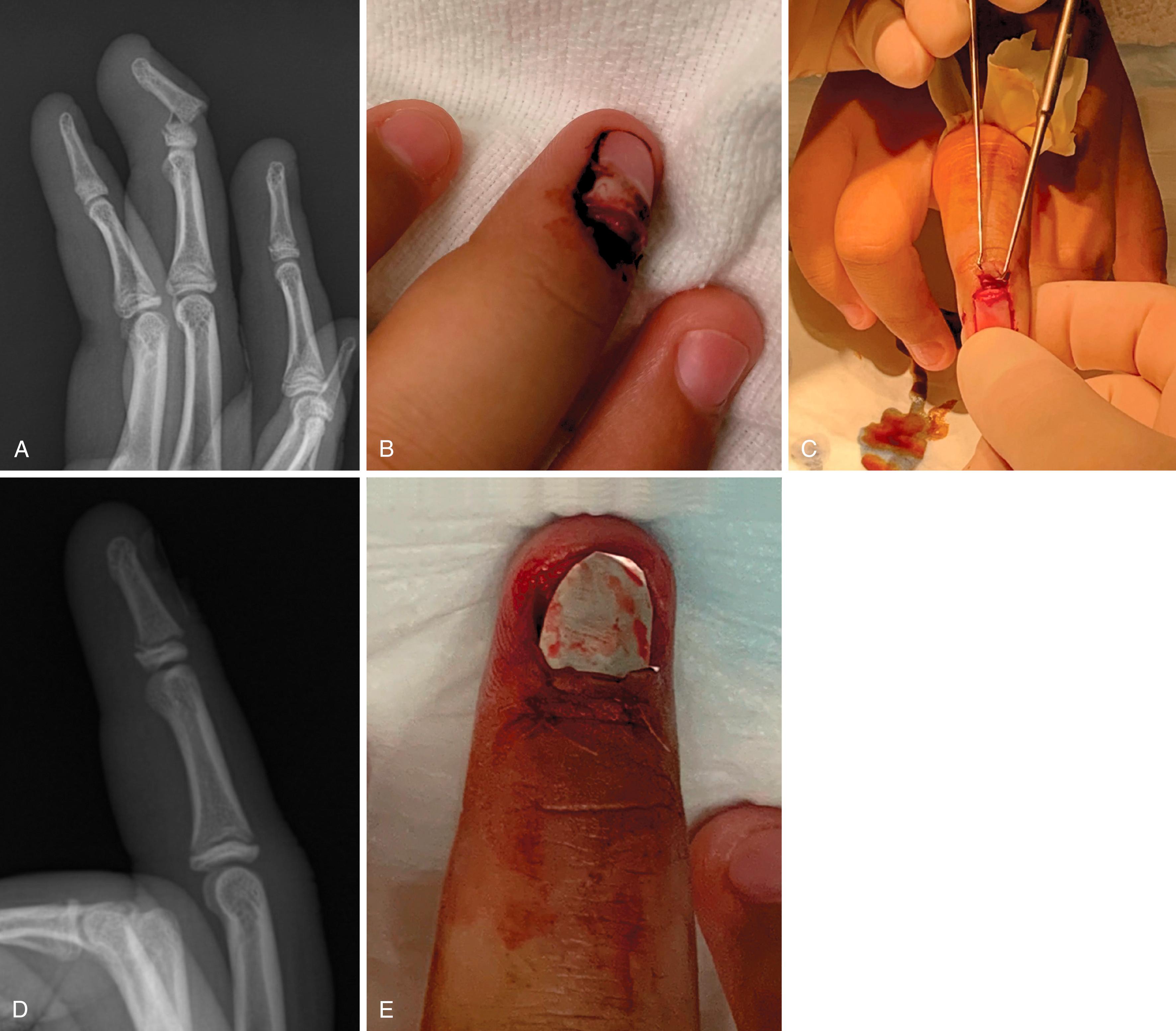
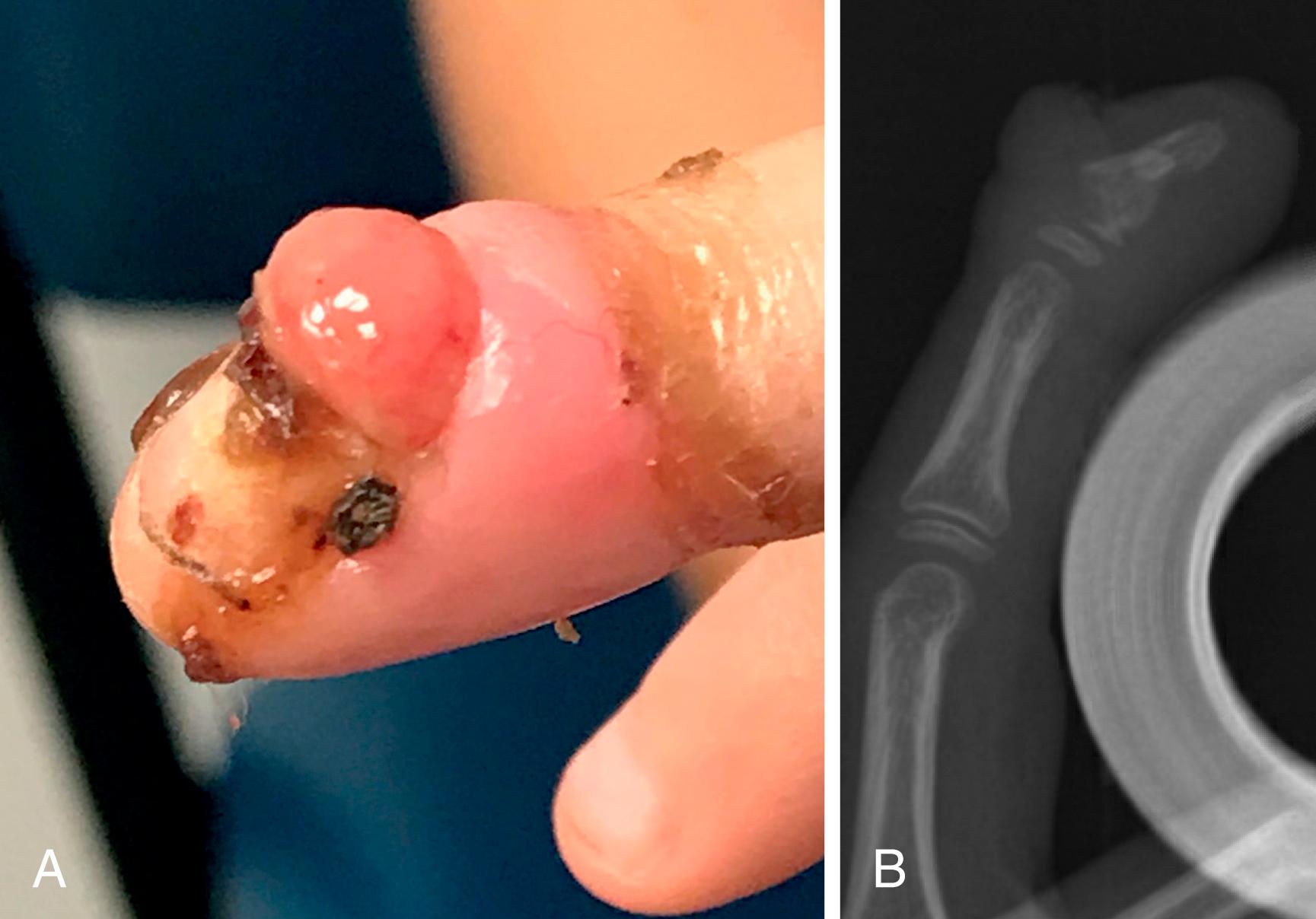
Salter-Harris III fractures of the dorsal base of the distal phalanx represent the pediatric equivalent of the adult mallet finger ( Fig. 41.8 ). Fracture displacement is caused by the proximal pull of the terminal tendon on the epiphyseal fracture fragment. Although the vast majority of these injuries can be treated successfully with extension splinting for 4 to 6 weeks, markedly displaced injuries accompanied by volar subluxation of the distal phalanx or articular incongruity unamenable to closed reduction merit surgical consideration. Treatment options include formal open reduction and internal fixation via a dorsal approach (with care to preserve terminal tendon attachments to the epiphyseal fragment), or closed reduction followed by transarticular or extension block pinning.
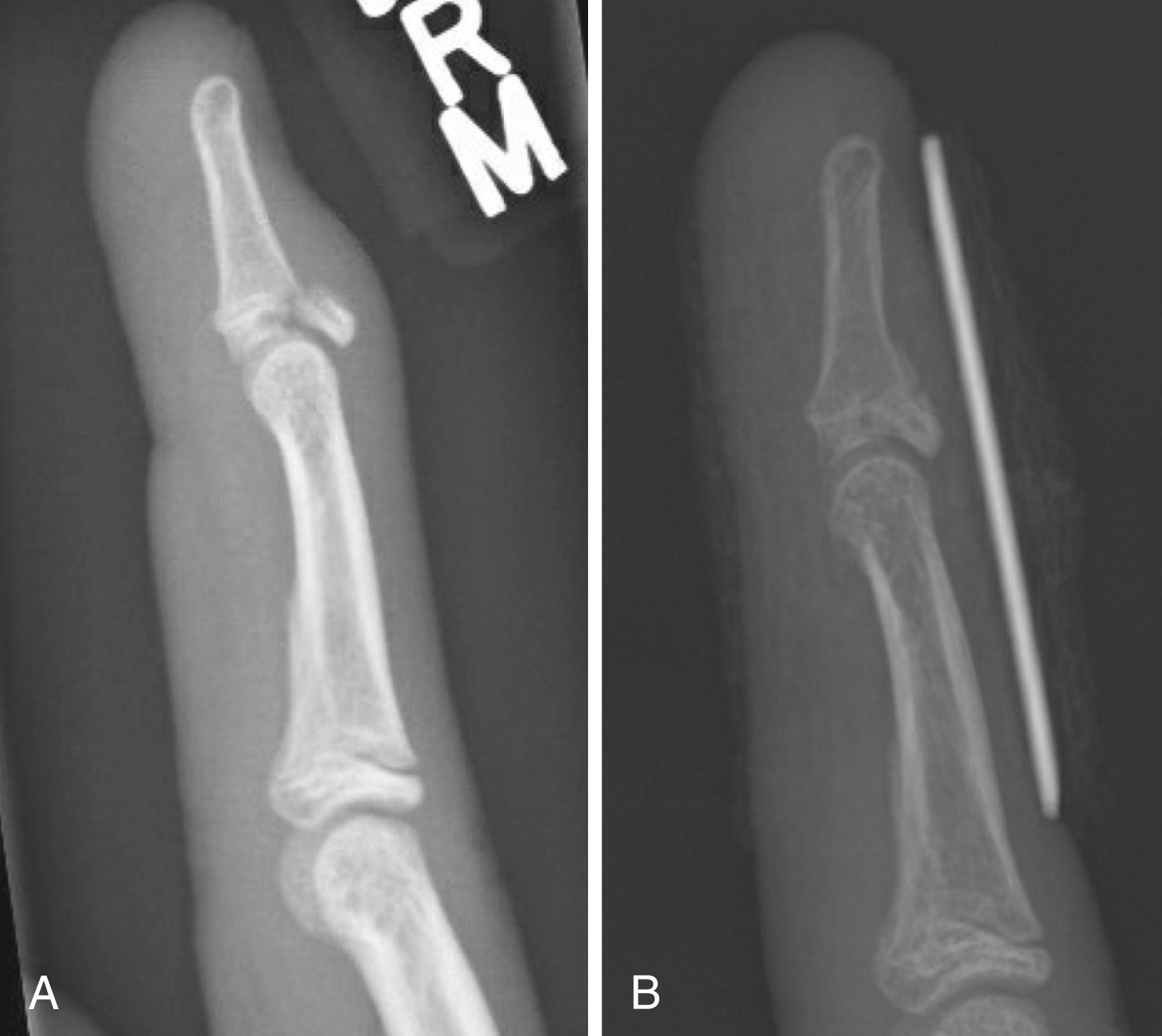
Rarely, injury to the distal phalangeal physis may result in extrusion of the epiphysis, the so-called epiphyseal dislocation ( Fig. 41.9 ). When the epiphysis is not ossified or incompletely ossified, radiographic findings may be very subtle. For this reason, careful correlation between radiographs and clinical examination is necessary. A heightened suspicion for underlying epiphyseal injury is necessary when there is a “flake,” “crescent,” or poorly defined opacity and an irregularity or incongruity of the DIP joint. Because the epiphysis typically displaces in a dorsal direction, a true lateral radiograph of the digit and DIP joint is necessary for diagnosis.
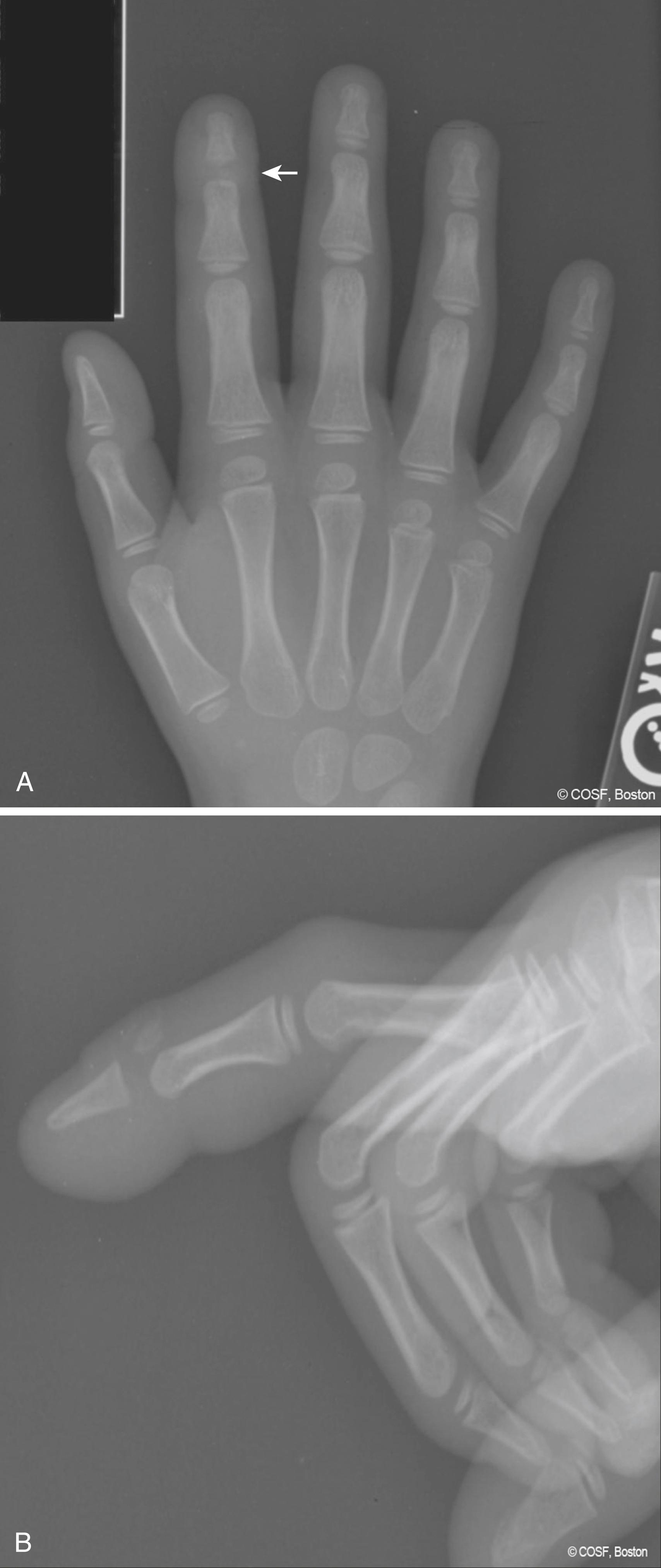
Physeal fractures resulting in pseudomallet deformity are treated with closed reduction and immobilization for 4 to 6 weeks. Variations of mallet splinting are viable options in older patients; however, cast immobilization is often needed in the young child to ensure compliance and protection of the injured digit. A Seymour fracture is suspected when there is an apex dorsal physeal fracture and an associated subungual hematoma. If there is any question, the nail plate should be removed, and appropriate soft tissue repair and bony stabilization performed, as described earlier. Widening of the dorsal phalangeal physis following closed reduction suggests soft tissue interposition and merits surgical intervention. Surgical treatment for dorsal Salter-Harris III fractures of the distal phalanx is reserved for patients with greater than 40% articular surface involvement and volar subluxation of the DIP joint, similar to adult bony mallet injuries. Percutaneous pinning techniques are preferred when adequate closed reduction can be achieved. Otherwise, open reduction is necessary to achieve fracture reduction.
Most distal phalangeal fractures can be treated nonoperatively with appropriate immobilization and care of associated soft tissue injuries.
A high index of suspicion is required for Seymour fractures, which should be treated with surgery including nail plate removal, fracture debridement and reduction, and nail bed repair.
Dorsal Salter-Harris III fractures represent the pediatric equivalent of adult bony mallet fractures, with the vast majority of injuries amenable to nonoperative treatment.
Fractures of the middle and proximal phalanx are categorized according to their location, pattern, and displacement. Fractures tend to occur at the distal articular surface, diaphysis, physis, or epiphysis. Each fracture has specific anatomic and treatment considerations and is discussed separately.
Prompt recognition and surgery for displaced phalangeal neck and intraarticular fractures reliably result in union and restoration of motion. A delayed presentation complicates surgical management and diminishes outcome.
Articular fractures of the head of the proximal and middle phalanges include unicondylar, bicondylar, and comminuted fracture patterns. Similar to adult injuries, treatment is predicated on restoration of articular congruity and correction of angular and rotational deformity. Nondisplaced injuries can be treated with cast immobilization. In these situations, however, weekly radiographic examinations should be performed to confirm maintenance of reduction and articular congruity. , In fractures with greater than 5 to 10 degrees of angulation or 1 to 2 mm of articular incongruity, surgical intervention is recommended. Closed or open reduction with smooth Kirschner wire or interfragmentary screw fixation is recommended ( ![]() ). Although closed reduction is desirable, an anatomic reduction is imperative to restore articular congruity. If closed reduction is not obtainable, open reduction is performed via a dorsal approach with visualization of the articular surfaces. The collateral ligaments and other soft tissue attachments to the condylar fracture fragments must be preserved to maintain fracture fragment vascularity. With careful surgical technique, restoration of an articular congruity, preservation of joint stability, and return of motion can be expected. Patients and families should be counseled, however, regarding the potential for long-term stiffness and arthrosis, particularly with severely displaced injuries requiring open treatment.
). Although closed reduction is desirable, an anatomic reduction is imperative to restore articular congruity. If closed reduction is not obtainable, open reduction is performed via a dorsal approach with visualization of the articular surfaces. The collateral ligaments and other soft tissue attachments to the condylar fracture fragments must be preserved to maintain fracture fragment vascularity. With careful surgical technique, restoration of an articular congruity, preservation of joint stability, and return of motion can be expected. Patients and families should be counseled, however, regarding the potential for long-term stiffness and arthrosis, particularly with severely displaced injuries requiring open treatment.
For displaced fractures of the phalangeal head, open reduction and internal fixation using smooth pins (or, less commonly, screws) is performed ( Fig. 41.10 ). A dorsal incision is centered over the IP joint, elevating soft tissue flaps while preserving the dorsal veins and subcutaneous nerves. The approach is between the extensor tendon and lateral bands mobilizing the extensor apparatus. The joint capsule is incised to visualize the fracture line(s) and articular surface. Soft tissue attachments to the displaced fracture fragments are preserved to maintain vascularity and ligamentous stability. Under direct visualization, the fracture is reduced and articular congruity is restored. Fixation is performed with smooth Kirschner wires and/or interfragmentary screws. Two points of fixation are necessary to provide rotational stability and stable fixation. Intraoperative fluoroscopy confirms reduction, and the pins are retained in a percutaneous position to facilitate removal. The skin is closed, and the patient is placed in a splint or short-arm cast. Pins are removed after 3 to 4 weeks and range-of-motion exercises are initiated.
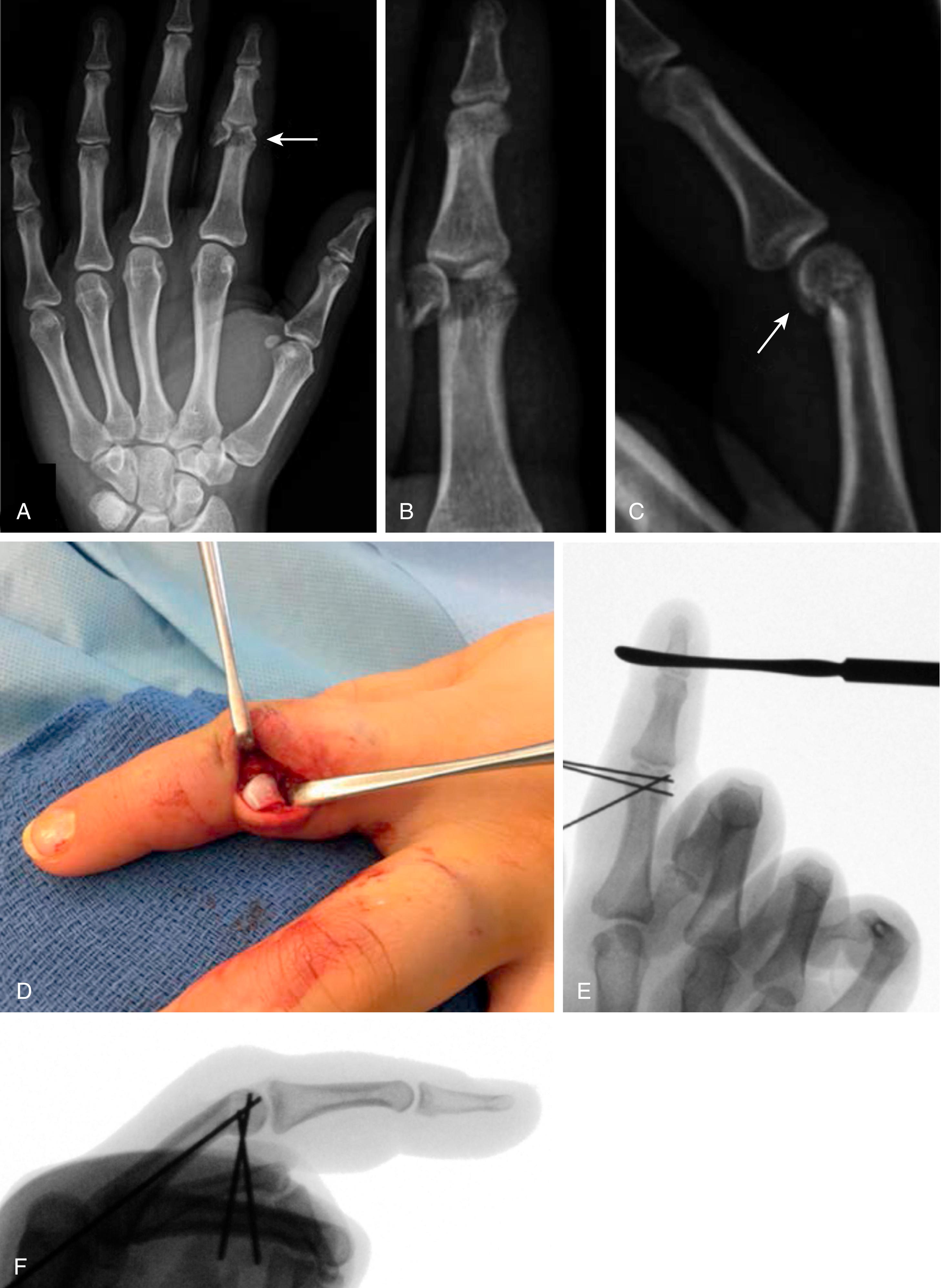
Phalangeal neck fractures are distinctive injuries of childhood. They are usually the result of “doorjamb” injuries where the digit is crushed or trapped in a door and forcefully withdrawn, imparting both extension and rotational forces. Border digits are most commonly affected, and the middle phalanx is injured more frequently than the proximal phalanx. The fracture occurs at the level of the phalangeal neck, and typically the distal articular segment is displaced into extension, with varying degrees of rotation. Patients present with swelling, tenderness, ecchymosis, and limited interphalangeal joint motion, although limited motion is often difficult to elicit in an acutely injured child. A slight angular deformity may be seen.
Careful radiographic evaluation is critical for a timely diagnosis and appropriate treatment. Because the distal fragment typically displaces dorsally, with apex volar angulation, standard AP views of the affected digit often appear benign. A true lateral radiograph of the injured digit is necessary. In addition, in very young patients the phalangeal head remains predominantly cartilaginous, so subtle or seemingly innocuous “bony flecks” should raise the suspicion of a displaced cartilaginous cap or osteochondral fracture. Although the radiographs may appear innocuous, displaced phalangeal neck fractures result in both abnormal digital alignment in the sagittal plane and disruption of the normally concave subcondylar fossa. Obliteration of the subcondylar fossa results in a bony block to IP joint flexion, as the adjacent phalangeal base abuts the bony prominence at the distal end of the proximal fracture fragment.
Al-Qattan’s classification of extraarticular phalangeal neck fractures is clinically useful because it infers prognosis and guides treatment. Type I fractures are nondisplaced; type II fractures are partially displaced, with some bony or cortical contact; and type III fractures are completely displaced without bony apposition. Cast immobilization is sufficient in cases of nondisplaced injuries, although serial radiographs are required to confirm maintenance of reduction. Closed reduction and splinting or cast immobilization are often insufficient for type II and III fractures. In the vast majority of cases, surgical treatment with closed reduction and percutaneous pin fixation is recommended ( Fig. 41.11 ). In Al-Qattan’s series of 66 patients with 67 phalangeal neck fractures, 13 fractures were nondisplaced and treated with nonoperative care with good to excellent results. Type II fractures accounted for the majority of injuries, and results were highly dependent on treatment. Patients treated with closed or open reduction and Kirschner wire fixation subsequently healed with good to excellent results. Type II injuries treated with closed reduction without surgical fixation achieved fair to poor results in 66% of cases. Among the seven type III injuries, failure to perform surgical reduction and Kirschner wire fixation uniformly led to fracture nonunion and poor results. Matzon and Cornwall have proposed a treatment algorithm for the care of acute type II phalangeal neck fractures, beginning with minimally invasive interventions and advancing to more advanced techniques as needed. In their series of 61 consecutive children, 49 patients were successfully treated with closed manipulation with percutaneous pin fixation and 12 underwent percutaneous pin-assisted reduction. No child with acute injuries required open reduction. Overall, the vast majority of patients achieved good to excellent results with low complication rates. In a more recent study, Boyer and colleagues found as high as a 4.8% complication rate, with short-term stiffness being the highest complication. However, patients reportedly had full range of motion 1 year following injury.
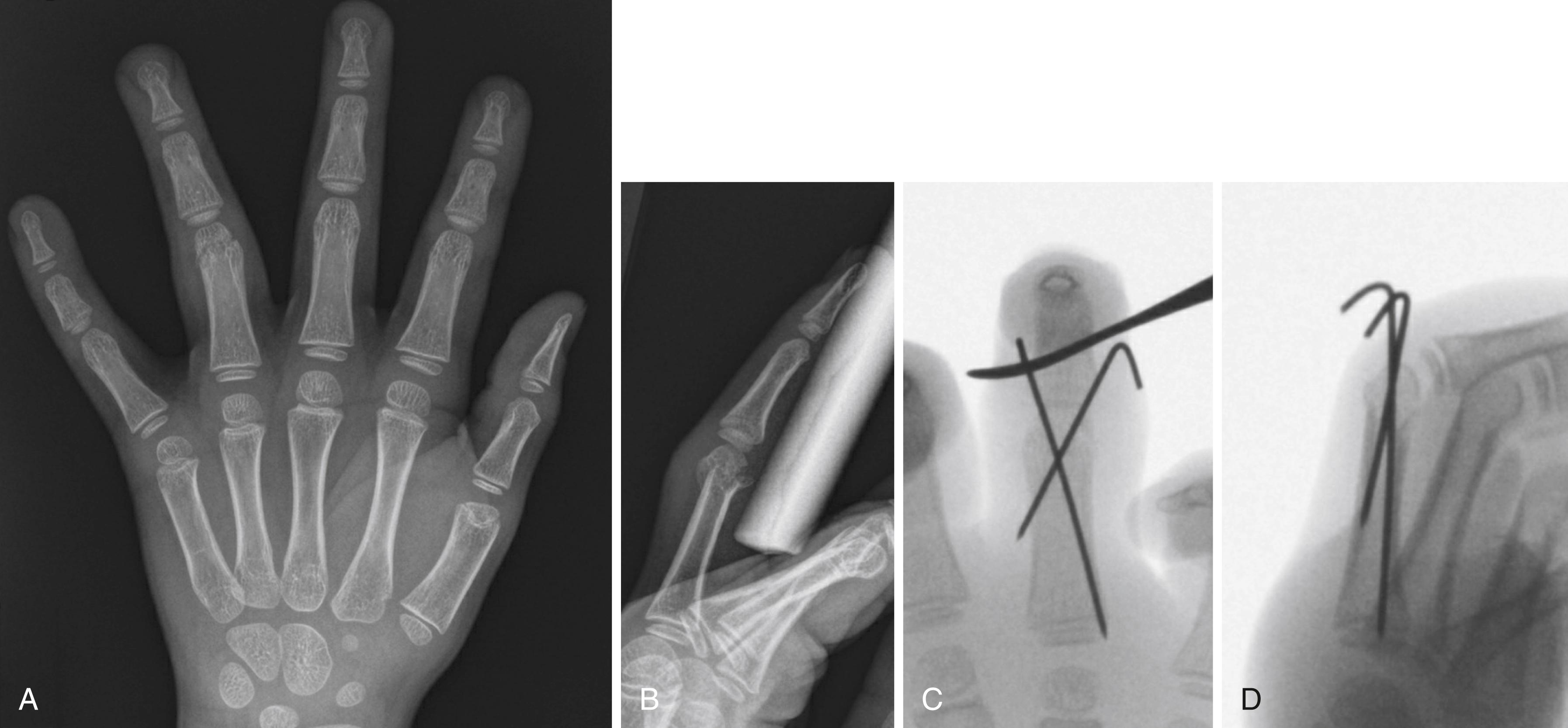
Since these injuries occur in the phalangeal neck and the physis is located at the proximal phalangeal metaphysis, remodeling potential is limited. There have been a handful of reported cases of complete skeletal remodeling of phalangeal neck malunions. Puckett et al. have previously published a retrospective case series of eight children with displaced phalangeal neck fracture malunions followed for a mean of 5 years after injury. In this small series of select, nonconsecutive patients, sagittal plane angulation improved from 31 to 0 degrees, whereas coronal plane alignment changed from 11 to 4 degrees. No patients reported functionally limiting loss of motion; however, two complained of persistent deformity in the coronal plane. The authors still recommended surgical reduction and stabilization for acute displaced phalangeal neck fractures; however, their results indicate these injuries have some remodeling capability.
Review of these case reports leads to a number of observations. First, phalangeal neck remodeling may be expected only in very young patients with considerable remaining growth. Second, sagittal plane deformity has the greatest remodeling potential, and coronal plane angulation or bony malrotation will not improve to the same extent. Third, while radiographic remodeling may be evident and IP joint motion improved, some cases achieve IP joint flexion only to 80 or 90 degrees. Finally, many reported cases involved the middle phalanx where the deformity is better tolerated due to the relatively less amount of DIP joint flexion needed for composite digital flexion and fist formation. Based on these published reports, observation of displaced phalangeal neck fractures should be considered only in the following circumstances: (1) if there is no rotational or coronal deformity, (2) the adjacent IP joint is intact, (3) substantial skeletal growth remains, (4) the resultant loss of IP joint flexion would be tolerable without undue functional compromise, and (5) the patient or family is willing to wait months to years for gradual remodeling. ,
In cases of late presenting, displaced phalangeal neck fractures with incipient malunion, percutaneous pin osteoclasis has been advocated as a way to restore bony alignment, improve IP joint J flexion potential, and minimize the risk of osteonecrosis. The most appropriate patients for percutaneous pin osteoclasis are those with persistent tenderness at the fracture site, a fracture line that is still radiographically apparent, and less than 90 degrees of corresponding IP joint flexion ( ![]() ).
).
In cases of phalangeal neck malunions, there is a temptation to perform a corrective osteotomy to restore bony alignment and IP joint motion. Formal open corrective osteotomy carries the substantial risk of osteonecrosis of the phalangeal head and is not recommended. In cases of long-standing phalangeal neck fracture malunions, subcondylar fossa reconstruction may be considered. , The concave fossa is recreated by removal of the healed fracture line and bone that has obliterated the fossa. Indications include persistent bony malalignment associated with restricted IP joint motion and functional compromise.
Phalangeal neck fracture nonunions are rare. Patients will present with complaints of instability, deformity, or stiffness. In the absence of osteonecrosis of the small articular fragment, bone grafting and longitudinal Kirschner wire fixation can result in healing, though often some residual stiffness remains.
Nondisplaced phalangeal neck fractures can be treated with cast immobilization, but weekly radiographs are required to assess for displacement. In type II or III injuries, closed reduction and percutaneous pinning via cross-pins are performed. Another potential technique is using a single intramedullary Kirschner wire for fixation. Patients are casted for 3 to 4 weeks, after which pins are removed and motion is initiated. In the rare situation with an irreducible fracture, open reduction can be performed via a midaxial approach with preservation of the collateral ligament and soft tissue attachments to the articular segment. In late presenting fractures with a nascent malunion, percutaneous pin osteoclasis is considered if the fracture is still radiographically visible and patients are tender to palpation at the fracture site ( Fig. 41.12 ). In late presenting cases with active or passive IP joint flexion to 90 degrees or more, observation is recommended. In established malunions with functionally limiting IP joint flexion, subcondylar fossa reconstruction via a volar or midlateral approach is performed. Rongeurs or burs can be used to remove the bone, obliterating the subcondylar fossa. Care is necessary to avoid overzealous resection as the dorsal bony bridge can become narrow when there is considerable dorsal displacement of the articular fragment. Intraoperatively, adequate bony resection is confirmed by passive IP joint flexion to 90 degrees or more. Early active and passive motion is initiated to maximize outcome.
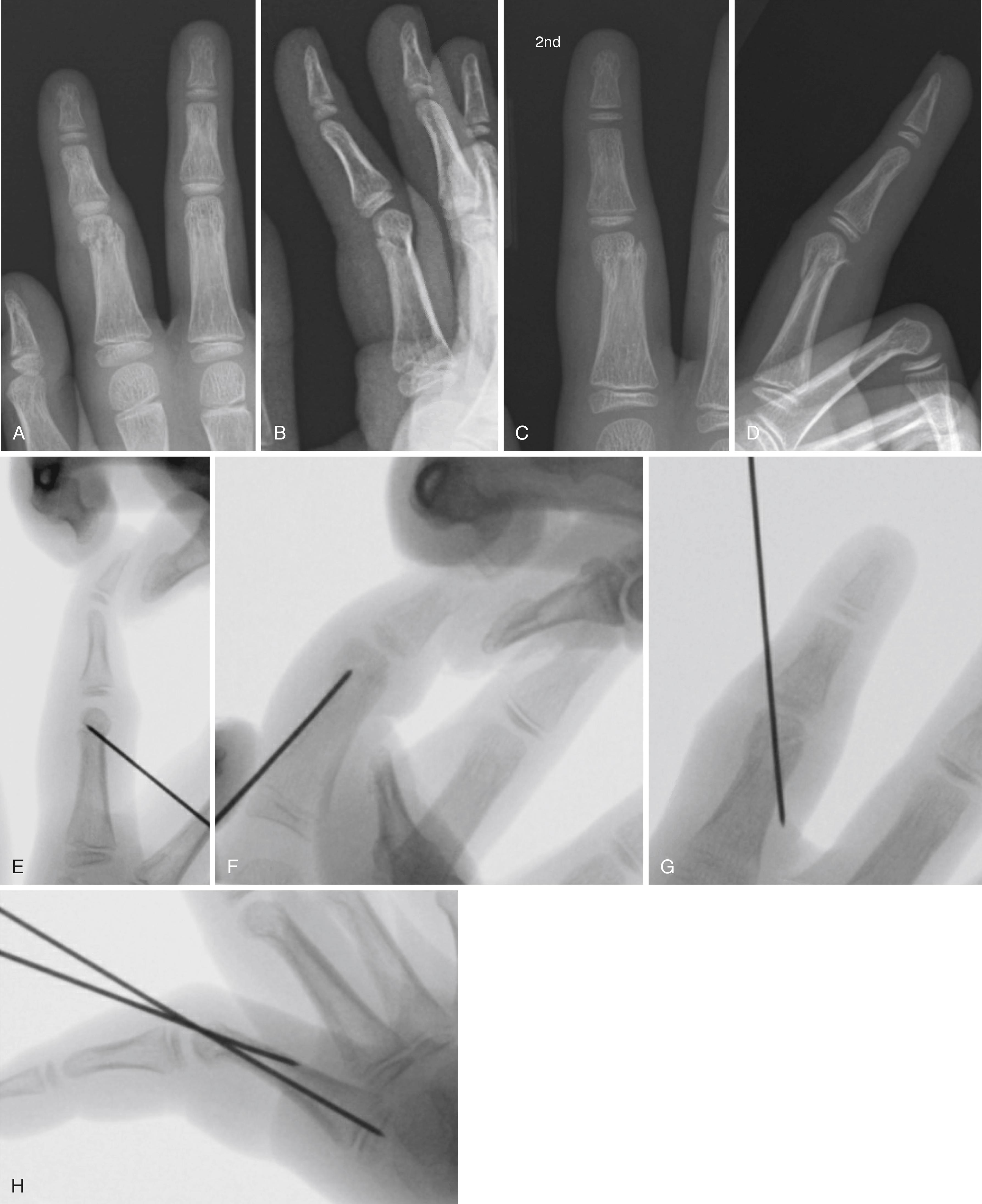
Diaphyseal fractures of the phalanges represent approximately two-thirds of phalangeal injuries. , The most common mechanism is combined bending and torsional forces sustained during falls or sporting activities. Proximal phalangeal shaft fractures usually exhibit apex volar angulation owing to the combined forces of the extensor mechanism on the distal fragment and intrinsic musculature on the proximal fragment. Conversely, fractures of the middle phalanx exhibit either apex palmar or dorsal angulation, depending on the location of the fracture in relationship to the flexor digitorum superficialis insertion. Fractures distal to the flexor digitorum superficialis insertion typically angulate apex volar, with the extensor mechanism pulling the distal fragment dorsally. Although up to 10 degrees of angulation is acceptable, closed reduction is recommended for greater amounts of angulation or any malrotation resulting in digital overlap or underlap. Al-Qattan et al. previously reported on 92 children studied prospectively with proximal phalangeal base fractures. The authors noted excellent outcomes in patients treated with closed reduction with or without percutaneous pinning for cases with greater than 10 degrees angulation, whereas remodeling was seen in patients with less than 10 degrees of radiographic angulation.
Following closed reduction and cast immobilization, serial clinical and radiographic evaluations are necessary to ensure maintenance of adequate alignment. In patients with irreducible or unstable fractures, surgical treatment via closed or open reduction and smooth pin fixation are recommended. In cases of long oblique fractures, two or more smooth Kirschner wires placed orthogonal to the fracture plane provide both axial and rotational stability ( Fig. 41.13 ). In transverse fractures, oblique cross-pinning may be used, although care should be taken to avoid crossing pins at the fracture site as this results in suboptimal fixation. Pins are left percutaneous and removed after 4 weeks, followed by motion exercises. Boyer et al. previously reported a series of 105 patients treated with percutaneous pinning for displaced proximal phalanx fractures. In this retrospective cohort, 36 patients developed postoperative stiffness with 31 requiring therapy to restore motion. Despite this high proportion of initial postoperative stiffness, patients with greater than 12 months follow-up regained full motion and excellent function.
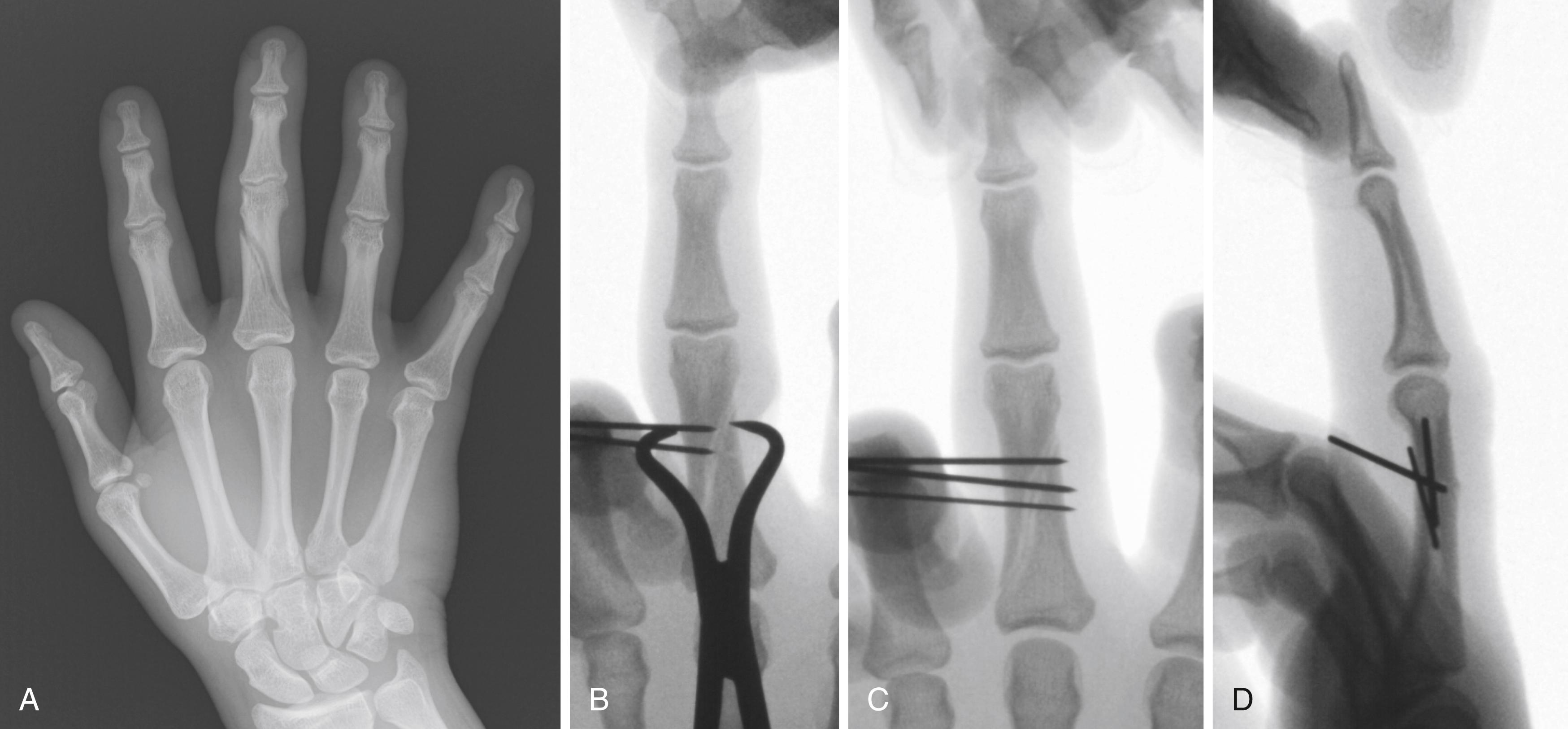
Closed reduction and cast immobilization are recommended for phalangeal shaft fractures with malrotation or angulation greater than 10 degrees. Serial radiographs are necessary to confirm maintenance of reduction. Immobilization is discontinued after 3 to 4 weeks, with a gradual return to activity. In cases of fracture instability or inadequate alignment, closed reduction and percutaneous pin fixation are performed (see Fig. 41.13 ). Pins are removed at 3 to 4 weeks, followed by range-of-motion exercises. Irreducible fractures require open reduction and pin fixation.
Physeal fractures of the phalanges are common injuries and occur secondary to combined bending and rotational moments sustained during falls and sporting activities. Patients and families may express anxiety upon learning of the occurrence of a growth plate fracture; however, multiple studies have demonstrated that one-third of all bony injuries of the growing hand involve the physis, and physeal arrest is uncommon. , , The proximal phalanx of the small finger is most commonly affected, resulting in the so-called extraoctave fracture ( Fig. 41.14 ). The thumb is injured in roughly one-fifth of cases. Physeal fractures of the middle phalanx are considerably less common than those involving the proximal phalanx. Salter-Harris type II patterns predominate owing to the anatomic features of the collateral ligaments described previously.
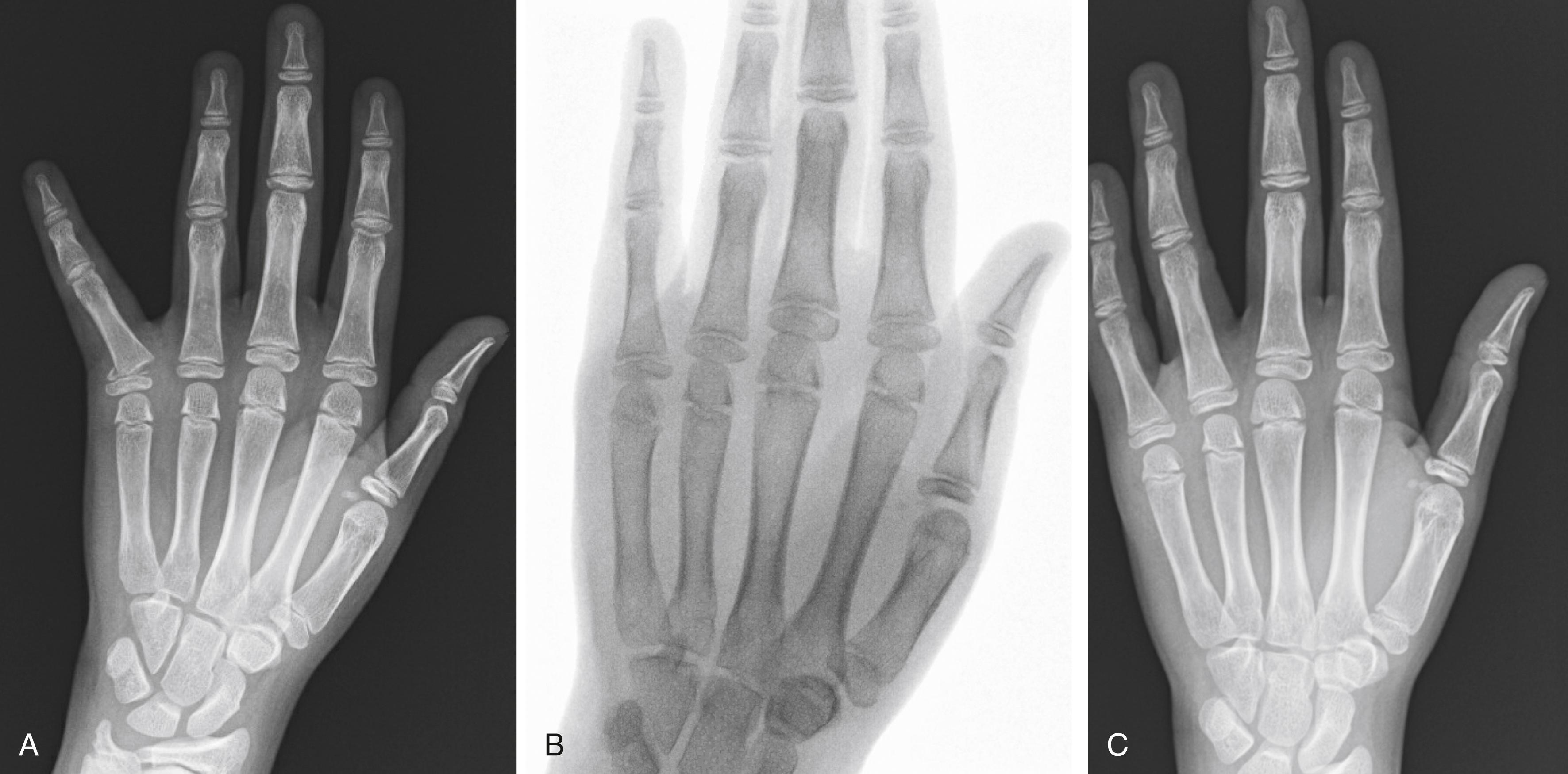
Closed reduction is recommended for fractures with greater than 10 degrees of angulation and any malrotation, owing to the limited remodeling potential of radioulnar (coronal plane) or rotational deformity. During closed reduction maneuvers, flexion of the MCP joint assists in stabilizing the proximal fracture fragment by tensioning of the collateral ligaments. A freer elevator or writing utensil can be placed in the adjacent web space at the apex of the deformity to serve as a fulcrum during angular correction. Following closed reduction, assessment of rotational alignment and radiographic confirmation of correction are essential for a successful outcome. Cast immobilization in the intrinsic-plus position is required for 3 to 4 weeks, followed by a gradual return to activity. Although splint immobilization and earlier motion have been advocated by some authors, the risks of noncompliance with a removable splint and the potential for loss of fracture reduction generally outweigh the benefits of early motion, particularly in young patients that do not develop posttraumatic stiffness.
In rare cases, these fractures may be unstable. Such fractures tend to be high-energy injuries that disrupt the stabilizing soft tissue envelope. In these cases, closed reduction followed by pin fixation is performed. The pins are left percutaneous to facilitate removal after 3 to 4 weeks. Smaller wires (ranging from 0.028 to 0.035 inch) and fewer wires may be utilized in young children compared with adults.
Closed reduction and cast immobilization are recommended for patients with greater than 10 degrees of angulation or malrotation (see Fig. 41.14 ). Stable fracture reduction is achieved in the majority of cases. Cast immobilization is discontinued after 4 weeks, followed by range-of-motion exercises. Percutaneous pinning is reserved for unstable or irreducible injuries with malrotation or greater than 10 to 15 degrees of angulation. Cast immobilization is discontinued and pins are removed at 3 to 4 weeks, followed by range-of-motion exercises.
Fractures of the phalangeal base with intraarticular extension represent Salter-Harris type III and IV injuries. In cases of articular incongruity, joint instability, or greater than 1 to 2 mm of displacement, closed or open reduction and smooth pin fixation are recommended to restore articular congruity, physeal integrity, and bony alignment. These injuries should be distinguished from volar plate avulsion fractures of the epiphysis. Similar to adults, small volar plate avulsions can be safely and effectively treated with simple Coban wrapping and “buddy taping” with early motion to avoid stiffness, provided the IP joint is stable and congruently reduced. In a prior study of 121 proximal IP joint hyperextension injuries randomized to either buddy taping or aluminum splinting, buddy taping was equally as effective as splinting. In general, children had better outcomes than adults.
Comminuted, unstable proximal interphalangeal fracture-dislocations are rare in children. Treatment principles are similar to those in adults. On occasion, closed techniques can be used ( Fig. 41.15 ). However, open reduction and internal fixation may be necessary to restore joint stability and reconstitute the articular surface. The volar base of the middle phalanx is approached via a volar zigzag incision. The A3–C1 pulleys are elevated in either a radial or ulnar direction, and flexor tendons are retracted to allow visualization of the joint surface and displaced fracture fragments. Anatomic reduction and restoration of joint congruity are performed, followed by stabilization with size-appropriate smooth pins or screws. Bone grafting may be required to fill any impacted metaphyseal defect. Although early motion is desired, 3 weeks of cast or splint immobilization are typically necessary owing to the tenuous fixation achieved and compliance issues in young patients.
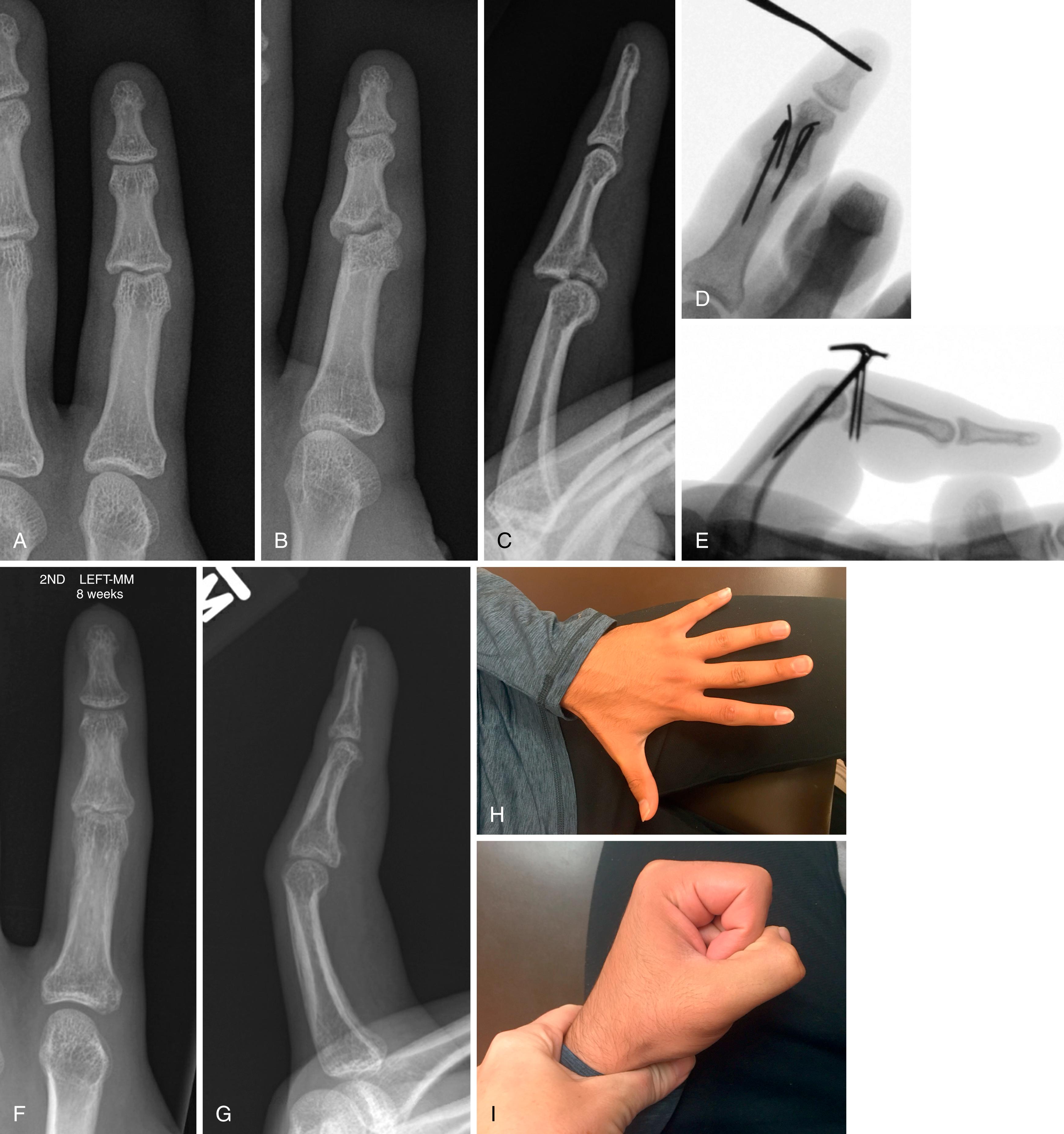
Closed or open reduction and internal fixation of displaced Salter-Harris III or IV fractures are performed for cases of articular incongruity or joint instability (see Fig. 41.15 ). Whereas radial and ulnar base fractures may be approached via a dorsal curvilinear incision, proximal interphalangeal fracture-dislocations with volar phalangeal base fractures require a more extensive volar approach to access fracture fragments and restore joint stability. Smooth pin fixation is used, supplemented by cast immobilization. Pins are removed in 4 weeks, followed by range-of-motion exercises.
Surgical treatment is recommended for all displaced articular fractures with care to preserve soft tissue attachments and vascularity to the displaced fracture fragment.
Displaced phalangeal neck fractures are treated with closed reduction and percutaneous pin fixation.
Percutaneous pin-assisted osteoclasis is effective in late presenting phalangeal neck fractures with persistent tenderness and radiographically visible fracture lines.
Subcondylar fossa reconstruction may be considered in established phalangeal neck fractures with functionally limiting loss of motion.
Surgical reduction and fixation are recommended for displaced Salter-Harris III and IV fractures to restore articular congruity and joint stability.
Treatment principles for metacarpal fractures in children are similar to those in adults. Metacarpal fractures arise from bending forces or axial loads sustained during falls, sporting injuries, or direct blows with a clenched fist. These fractures result in apex dorsal angulation secondary to the intrinsic musculature. Mild to moderate apex dorsal angulation results in little to no compromise of hand function. In contrast, excessive angulation results in both esthetic consequences, difficulties with digital extension (i.e., pseudo–claw deformity), and/or discomfort with forceful grasp. Closed reduction and pin fixation or open reduction for multiple metacarpal fractures results in union and return of function. Open reduction and internal fixation of intraarticular metacarpal head fracture can achieve articular restoration, but stiffness is common.
There is substantial variation in what is deemed “acceptable” angulation in metacarpal neck and shaft fractures. Each patient merits individualized decision making. Most authorities agree that 30 degrees or less of sagittal plane deformity is acceptable in physeal fractures, particularly in young patients with growth remaining and remodeling potential. Twenty to 45 degrees of apex dorsal angulation is acceptable in metacarpal neck fractures, with greater deformity allowable in the more ulnar digits. Shaft fractures tolerate less angular deformity, 10 to 15 degrees of angulation is acceptable in the index and long fingers and 30 to 40 degrees in the ring and small fingers. Even mild rotational deformity (>10 degrees) results in digital overlap with functional problems and should be avoided. Malrotation is often undetectable on radiographic evaluation and the importance of a thorough physical examination cannot be overstated.
In general, metacarpal fractures can be considered according to their anatomic location: epiphyseal, diaphyseal, neck, physeal, and articular fractures.
Fractures of the metacarpal epiphysis are rare and are usually Salter-Harris III or IV fractures. , These injuries result from axial loads during falls or closed fist injuries. Although nondisplaced injuries may heal satisfactorily with cast immobilization, open reduction and internal fixation are recommended for displaced fractures with articular incongruity. Internal fixation using countersunk interfragmentary screws can be used in older adolescents; however, smooth Kirschner wire fixation is preferred in younger children. Kirschner wire fixation provides adequate fracture stability and minimizes the risk of iatrogenic physeal injury. Rarely, there is extensive comminution of primarily cartilaginous fragments, and bioabsorbable pin or suture fixation is used. Osteonecrosis has been reported following these severe injuries, and preservation of any soft tissue attachments to the displaced fracture fragments is recommended. Torre has proposed that increased intracapsular pressure secondary to fracture hematoma may play a causative role, but there is little evidence to support this assertion.
Become a Clinical Tree membership for Full access and enjoy Unlimited articles
If you are a member. Log in here